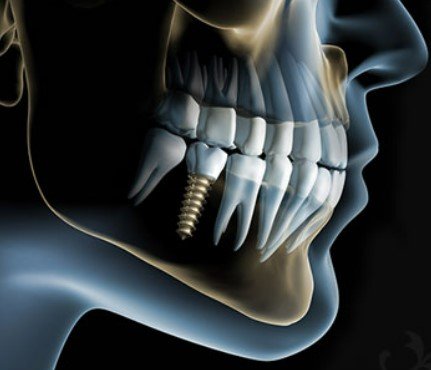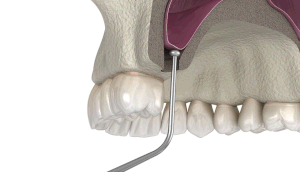






DRM
Slider1
Slider2
Slider3
DRA
Slider4
slider5


Sinus lift surgery is a treatment approach your dentist may recommend when you desire dental implants but don’t have enough jaw bone to secure the implant.
 A sinus lift (or sinus augmentation) can correct this issue by lifting the sinus floor and promoting the development of new bone for dental implant placement.
What is Involved in getting a Sinus Lift?
There are many techniques that may be used to raise your sinus to allow for new bone growth (see Figure 2). A common technique is exposing the bone by incision. A small circle is then cut into your bone. This piece of the bone piece is placed in the sinus cavity, and underneath the space is filled with bone graft material (see Figure 3). Dr. Padhye will explain what types of material can be used for the bone graft which will regenerate lost tissue and bone.
A sinus lift (or sinus augmentation) can correct this issue by lifting the sinus floor and promoting the development of new bone for dental implant placement.
What is Involved in getting a Sinus Lift?
There are many techniques that may be used to raise your sinus to allow for new bone growth (see Figure 2). A common technique is exposing the bone by incision. A small circle is then cut into your bone. This piece of the bone piece is placed in the sinus cavity, and underneath the space is filled with bone graft material (see Figure 3). Dr. Padhye will explain what types of material can be used for the bone graft which will regenerate lost tissue and bone.
 The incision is then closed and natural healing is allowed to begin. Usually, the bone will need to develop from four to 12 months, depending on your individual needs, before an implant can be placed (see Figure 4).
The incision is then closed and natural healing is allowed to begin. Usually, the bone will need to develop from four to 12 months, depending on your individual needs, before an implant can be placed (see Figure 4).

What is Sinus Lift Surgery?
The maxillary sinuses are behind your cheeks and on top of the upper teeth. These sinuses are empty, air-filled spaces. Some of the roots of the natural upper teeth extend up into the maxillary sinuses. When these upper teeth are removed, there is often just a thin wall of bone separating the maxillary sinus and the mouth. Dental implants need bone to hold them in place. When the sinus wall is very thin, it is impossible to place dental implants in this bone. The key to a successful and long-lasting dental implant is the quality and quantity of jawbone to which the implant will be attached. If bone loss has occurred due to injury or periodontal disease, a sinus augmentation can raise the sinus floor and allow for new bone formation. A sinus lift is one of the most common bone grafting procedures for patients with bone loss in the upper jaw. The procedure seeks to grow bone in the floor of the maxillary sinus above the bony ridge of the gum line that anchors the teeth in the upper jaw. By strengthening and growing bone in this location, dental implants can be placed and secured in the new bone growth.Are You a Candidate for a Sinus Lift Procedure?
A sinus lift may be necessary if you: • are missing more than one tooth in the back of your jaw. • are missing a significant amount of bone in the back of your jaw. • are missing teeth due to a birth defect or condition. • are missing most of the maxillary teeth, but require support for dental implants. Why do I need a Sinus Lift? When you are getting implants, the key to their success is the quality and quantity of the bone where the implant will be placed. The most difficult area to place dental implants is in the upper back jaw because there is insufficient bone and is in very close proximity to your sinus. If you have lost bone in the upper back jaw due to tooth loss or periodontal disease, there may not be enough bone to place a dental implant (see Figure 1). A sinus lift (or sinus augmentation) can correct this issue by lifting the sinus floor and promoting the development of new bone for dental implant placement.
What is Involved in getting a Sinus Lift?
There are many techniques that may be used to raise your sinus to allow for new bone growth (see Figure 2). A common technique is exposing the bone by incision. A small circle is then cut into your bone. This piece of the bone piece is placed in the sinus cavity, and underneath the space is filled with bone graft material (see Figure 3). Dr. Padhye will explain what types of material can be used for the bone graft which will regenerate lost tissue and bone.
A sinus lift (or sinus augmentation) can correct this issue by lifting the sinus floor and promoting the development of new bone for dental implant placement.
What is Involved in getting a Sinus Lift?
There are many techniques that may be used to raise your sinus to allow for new bone growth (see Figure 2). A common technique is exposing the bone by incision. A small circle is then cut into your bone. This piece of the bone piece is placed in the sinus cavity, and underneath the space is filled with bone graft material (see Figure 3). Dr. Padhye will explain what types of material can be used for the bone graft which will regenerate lost tissue and bone.
 The incision is then closed and natural healing is allowed to begin. Usually, the bone will need to develop from four to 12 months, depending on your individual needs, before an implant can be placed (see Figure 4).
The incision is then closed and natural healing is allowed to begin. Usually, the bone will need to develop from four to 12 months, depending on your individual needs, before an implant can be placed (see Figure 4).

How should I prepare for Sinus Lift Surgery
- Eat and drink as normal before procedures with local anaesthetic and sedation.
- Take your usual medications.
- Take the same painkillers you would take for headaches, e.g. Ibuprofen, before the sinus lift.
- Bring any retainers your dentist gave you to wear during your scan before the sinus lift.
- Arrive by your allotted appointment time.
Most sinus lift procedures are performed with you awake using local anaesthesia to numb the area. Sedation with a local anaesthetic, or use general anaesthetic, is used only when surgery will be difficult or when multiple procedures are required.
The procedure may take 45 minutes to two hours to perform depending on the complexity. We might give you antibiotics just before the sinus lift. You will not need to arrange an escort to take you home unless sedation or general anaesthetic is used.